Heterogeneous Vehicular Communication Architecture and Key Technologies
This work was funded by the National High Technology Research and Development Program of China ("863" Program) under Grant No. 2007AA01Z239, and the National Science and Technology Major Projects under Grant No. 2011ZX03001-007-03.
With the rapid development and convergence of computers, communications, and microelectronics, a solid foundation has been laid for the application of communications network technologies. In recent years, rapid growth in the number of vehicles on the road has increased demands for communication on the move. This has been the impetus behind installation of communications networks in passenger vehicles. Wireless access in vehicular environments has become a hot research topic worldwide, and such research will promote the development of intelligently networked vehicles in the future.
Traditional vehicular communication networks are closed and designed for specific uses, such as Electronic Toll Collection (ETC). However, vehicular networks are now being designed to support transmission of safety and other information between vehicles. Current vehicular communication systems, with some weaknesses in architecture, can only support data exchange between high-speed vehicles in local areas. New-generation vehicular networks will communicate safety data, information about traffic, and multimedia digital services. Therefore, new-generation vehicular networks must be capable of providing high priority real-time services between vehicles and intelligent transport centers and must also support wireless Internet access for passengers. Real-time services include traffic reports and location-based mapping; multimedia services include news, promotional, and entertainment information. How to best provide these services is an important and emerging topic of research. Vehicular mobile architecture converged with heterogeneous wireless networking is proposed in this paper. Vehicular Ad-Hoc Network (VANET) based on IEEE 802.11p Wireless Access in Vehicular Environments (WAVE) is integrated with broadband wireless access system based on IEEE 802.16e Worldwide Interoperability for Microwave Access (WiMAX). Key technologies used in this the solution are also discussed.
1 Research Progress and Development Trends of Vehicular Communication Networks
Many research organizations have applied advanced communications technologies to transportation systems with the aims of improving security, intelligence, and efficiency. VANET can facilitate Vehicle-to-Vehicle (V2V) communications between fast moving vehicles as well as Vehicle-to-Infrastructure (V2I) communications when vehicles are slowly moving or stationary. It provides various safety and non-safety applications.
In developing the specifications for WAVE, the IEEE 802.11p working group—set up in 2004—used the IEEE 1609 standard family as the upper layer protocol, and this has become the basic protocol architecture for vehicular communications[1]. Professor Nitin Vaidya and his team at the University of Illinois, Urbana-Champaign, developed a multichannel wireless mesh testbed, and Professor G. Pau from UCLA proposed Practical Vehicular Routing Protocol (PVRP), setting up a system test platform for verification. Professors Jinhua Guo and Weidong Xiang from the University of Michigan developed a 5.9 GHz WAVE system channel testbed.
In terms of wireless access in vehicular networks, the bulk of research is based on IEEE 802.11. However, IEEE 802.11 has some weaknesses: It has limited coverage, requires frequent handover when a moving vehicle connects to roadside infrastructure, has weak support for Quality of Service (QoS), and has weak support for high-quality multimedia[2-3]. IEEE 802.16 is a solution to these problems. WiMAX (IEEE 802.16) supports wide coverage and guaranteed QoS, and has attracted much attention in recent years.
References [4] and [5] show the first application of WiMAX into vehicular networks for broadband wireless access. This represents the first vehicular communication network that is not based on IEEE 802.11. WiMAX base stations have a reasonable coverage of several kilometers in urban areas, providing higher data rates and wider coverage than IEEE 802.11 systems.?The IEEE802.16j working group on Mobile Relay Stations (MRS) was set up in March 2006 with the goal of developing vehicular MRSs for broadband wireless access in moving vehicles[6].
Current topics of research in vehicular mobile networks include WAVE (IEEE 802.11p) multichannel coordinated applications and multicast routing management as well as handover and resource scheduling in WiMAX (IEEE 802.16) fixed relay technology.
In VANET, all applications related and unrelated to safety are implemented on the same channel, which makes it difficult to guarantee QoS. Mass data unrelated to safety congests traffic and prevents safety data from being effectively transmitted. This can seriously affect the safety performance of VANET. A direct and effective solution to this issue is multichannel Media Access Control (MAC)[7]. With multichannel MAC, nodes can use different channels to communicate with each other and access is more flexible. A multichannel network has better throughput and less delay than a single-channel network. Timeslot intervals are generally used to alternatively divide time into control intervals and data exchange intervals[8-9]. All nodes negotiate on Control Channel (CCH) within a CCH interval, and then move to other channels to transmit data within a Service Channel (SCH) interval.
Figure 1 illustrates a VANET based on multichannel MAC.
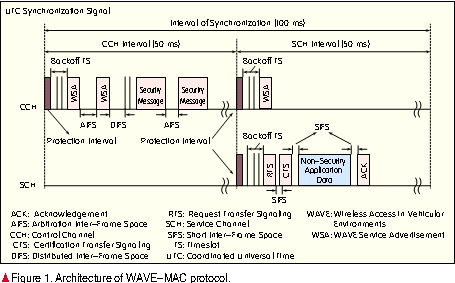
The original WAVE routing mechanism is not adaptable to vehicular networks with dynamically changing topologies. Proactive table-driven routing protocol fails to coordinate nodes that cannot be determined in advance in a transport environment. Moreover, frequent topological changes seriously affect the protocol’s performance. On the other hand, reactive source-driven routing protocol does not establish a route until a message is being sent, and the route expires after some time. These routing protocols struggle to meet the low-delay requirements of safety applications because an increase in communication hops or vehicle speed causes a longer delay in establishing a route. Therefore, location-based multicast routing technology must be merged[10-11]. The goal of multicast routing is to transfer a message from the source node to all nodes within a Zone of Relevance (ZoR). A vehicular network using multicast routing can be organized into multiple peer units (clusters) in order to improve scalability in mobile environments[12]. The VANET clustering mechanism enables rapid and effective intra-cluster communication of safety messages, and inter-cluster communication for multihop message transmission to far areas. This cluster-based routing mechanism not only enables comprehensive message coverage but also has low delay. Therefore, it can be used to deliver all kinds of messages to moving vehicles. Cluster-based multicast routing will have safety applications in vehicular networks. A cluster header is treated as a coordinator, which collects and delivers real-time safety warning messages in the cluster and transfers processed safety messages to neighboring cluster headers.
Communication between vehicles and roadside infrastructure is possible only when a vehicle is moving slowly or it is static. That is to say, a fast moving vehicle cannot have sustained interaction with roadside infrastructure. Vehicular MRSs are introduced between intra-vehicle user terminals and roadside base stations to facilitate interaction. The concepts of hierarchical scheduling and group mobility emerge from an MRS-based vehicular communication system. MRS acquires allocated resources from base stations and user terminals in vehicles acquire resources from MRS in a process called two-level resource scheduling. If communication links from vehicles belong to the same service type and have similar QoS requirements, MRS will bind the links for centralized handover processing. Group handover reduces the number of signaling interactions between each terminal and the base station.
A two-level resource scheduling mechanism based on fixed relays[13] improves system throughput and decreases packet loss rate and delay. A relay-assisted handover technique using network coding over multihop cellular networks[14] ensures channel QoS parameters and reduces the call drop rate by transferring data through relay nodes. In MRS-based group handover[15], MRS assists vehicles to complete handover to destination base stations, and also reallocates resources during the process so that congestion and delay are reduced and handover is successful.
Within a radius of several hundred meters, WAVE can transmit real-time text and image messages to intersections, gas stations, and parking lots at tens of megabytes per second. It can also provide moving vehicles with pre-collision warning. On the other hand, WiMAX supports communication within a radius of several thousand meters and can be applied in vehicles moving at over 120 km/h. MRS in WiMAX system provides good system gains and facilitates high-rate communication for vehicles. Therefore, a heterogeneous vehicular communication architecture based on converged WiMAX and WAVE is recommended. This architecture is capable of safety communications, transferring transportation data, and wireless broadband multimedia data transmission.
2 Heterogeneous Vehicular Communication Architecture and Its Reference Model
2.1 System Architecture
In the architecture proposed in Figure 2, WAVE facilitates V2V communications and WiMAX facilitates V2I communications. MRS is applied between user terminals in vehicles and roadside infrastructure. This architecture supports emergency V2V communications, guaranteeing proactive vehicular safety. Moreover, MRS also enables broadband wireless access in vehicles. Reliable, real-time data interaction is possible between users and intelligent transport centers, and multimedia data services can be accessed on the Internet. Figure 3 shows the protocol structure of this architecture. V2V communications and transferring of safety data can be reliably carried out using IEEE 802.11p VANET. Vehicular wireless broadband can be accessed over IEEE 802.16 metropolitan networks. Users can upload or download at high speeds, and handover can be conducted as a whole through MRS.
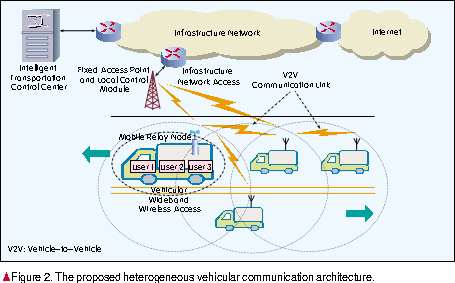
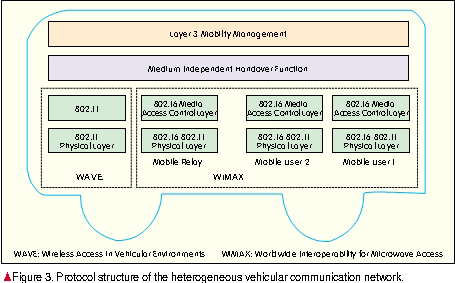
2.2 Communication Protocol Module
A heterogeneous vehicular communication network ensures multimode terminals in moving vehicles receive data services over IEEE 802.11 and IEEE 802.16 networks. However, these two kinds of networks have different MAC and upper-level mobility management protocols. Therefore, in order to offer handover service in the heterogeneous network, a media independent handover technology between L2 and L3 protocols is necessary. In the solution proposed in this article, IEEE 802.21 Media Independent Handover Function (MIHF) module[16] is used. This module enables network discovery and selection, initiates handover, and optimizes power consumption of heterogeneous networks based on 3G, WiMAX, and Wireless Fidelity (Wi-Fi). In a heterogeneous vehicular network using the MIHF module, handover delay and packet loss tolerance are greatly improved. Figure 4 shows the layers and modules of the entire network.
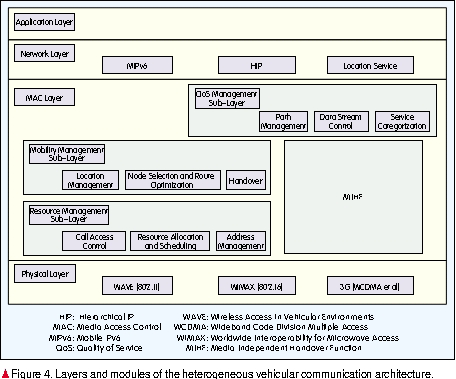
2.3 Field Test Platform
Using a laboratory simulation testbed, a field test platform for the heterogeneous vehicular communication network was built around the Jiading Campus of Tongji University and Caoan Road in Shanghai. The V2I and V2V field test schemes have WiMAX vehicular broadband wireless access and WAVE vehicular ad-hoc communications. As shown in Figure 5, the field test platform supports high-speed transmission of V2V safety data. Vehicles can exchange data such as traffic conditions with the intelligent transport center and can access digital multimedia services on the Internet.
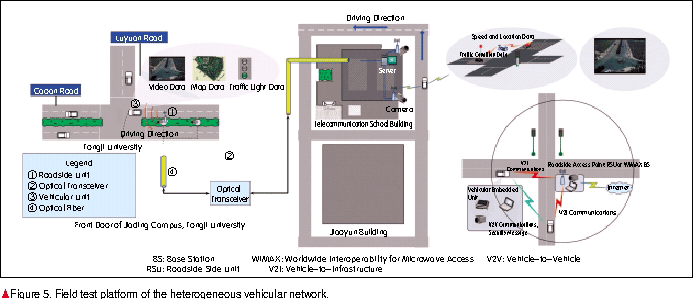
3 Key Technologies in a Heterogeneous Vehicular Communication Network
3.1 Distributed Channel Scheduling and Channel Adaptive Coordination Mechanism Based on Link State
A channel coordination mechanism based on timeslot intervals and Time Division Multiple Access (TDMA) is used to form the basic protocol structure for the proposed architecture. A synchronization interval contains a control window and a data exchange window. Each window is further divided by timeslots. The control window is used for broadcasting safety and control messages, while the data exchange window is used to unicast or locally broadcast messages that are not related to safety. Figure 6 shows the proposed VANET multichannel MAC protocol framework. The channel adaptive coordination mechanism dynamically adjusts control and data exchange window intervals according to traffic load. According to the frequency and time, the distributed channel scheduling algorithm allocates optimal resources to nodes in local areas, improving channel utilization and throughput.
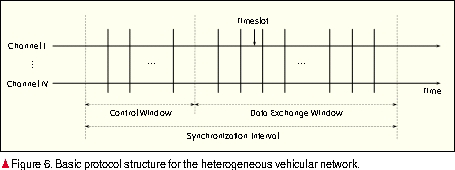
3.2 Location-Based Routing Algorithm
In current vehicular networks, the relative locations of nodes can be acquired by link predication based on which routes are selected. To relieve the burden on the data link layer, Global Positioning System (GPS) equipment can be used to provide location data. Based on mobility predication on moving vehicles and an enhanced cluster-based algorithm, the message broadcasting mechanism guarantees that messages are rapidly and stably transferred in the event of an accident. Therefore, cluster broadcast routing algorithm based on mobility prediction is necessary in the proposed architecture. Also, in order to guarantee QoS and reduce delay for high-speed topology changes frequently, it is necessary to predict the location, speed, and acceleration of nodes. The connection duration must be estimated, and route discovery process must be initiated before the current route is disconnected.
3.3 MRS-Based Group Handover Mechanism
Group handover refers to simultaneous handover of multiple terminals in a moving vehicle from the serving base station to another base station. During a group handover, resources are reallocated to guarantee QoS at different service levels. Mobile user mobility prediction technology can be used to estimate resource reservation during handover, which helps reduce handover calls admission drop rate and delay. Research into MRS group handover is focused on the design of mobility prediction group handover procedure, admission control strategy for handover based on sub-channel reallocation, and speed adaptive handover algorithms.
3.4 Relay-Based Two-Level Hierarchical Scheduling Algorithm
With the introduction of relay technology into vehicular networks, relay nodes appear in vehicular broadband wireless access systems. Base stations and user terminals signal to each other through relay stations rather than communicate directly. The concept of hierarchical scheduling thus emerges. Hierarchical scheduling uses a central scheduling mechanism for resource scheduling at the base station and relay node. Since a relay node has powerful processing capabilities, such as partial base station function, it can assist base stations to make a schedule mapping from the vehicular terminal to broadband wireless access base station on optimal resource allocation. This reduces the burden on base stations and improves system throughput and data rates. The two-level hierarchical scheduling algorithm follows network environment changes and implements two-level Dynamic Bandwidth Allocation (DBA) under a "vehicle-MRS-roadside base station" three-layer structure. Frequency utilization is thereby improved, and services are provided with QoS guarantees.
4 Conclusion
Convergence of VANET and broadband wireless access networks is an important component of new-generation wireless broadband mobile networks and a major goal of China’s 11th five-year science and technology development plan. The new converged vehicular network is expected to boost QoS in urban intelligent transportation systems, help in the construction of urban broadband wireless information systems, and support digitally networked cities. To these ends, a hybrid vehicular mobile communication architecture based on WAVE and WiMAX is proposed. Its protocol module structure is given, and key technologies are analyzed. These technologies include multichannel coordination and scheduling, multicast routing in VANET and group handover, and hierarchical resource scheduling and allocation. For future heterogeneous vehicular communication networks, further research will be needed into important technologies such as QoS guarantee at high mobile speed and seamless handover of moving vehicles over heterogeneous networks.
References
[1] ASTM E2213-03. Standard Specification for Telecommunications and Information Exchange Between Roadside and Vehicle Systems-5 GHz Band Dedicated Short Range Communication (DSRC) Medium Access Control (MAC) and Physical Layer (PHY) Specifications[S]. 2003.
[2] YIN Jijun, ELBATT T, YEUNG G, et al. Performance Evaluation of Security Applications over DSRC Vehicular Ad Hoc Networks [C]//Proceedings of the 1st ACM International Workshop on Vehicular Ad Hoc Networks (VANET’04), Oct 1, 2004, Philadelphia, PA, USA. New York, NY, USA: ACM, 2004: 1-9.
[3] IEEE Std 802.16e. IEEE Standard for Local and Metropolitan Area Networks, Part 16: Air Interface for Fixed and Mobile Broadband Wireless Access Systems [S]. 2006.
[4] YANG K, OU S, CHEN H, et al. Amultihop Peer Communication Protocol with Fairness Guarantee for IEEE 802.16 Based Vehicular Networks [J]. IEEE Transactions on Vehicular Technology, 2007, 56 (6): 3358-3370.
[5] SHAN L, LIU F, YANG K. Performance Analysis of Group Handover Scheme for IEEE 802.16j-Enabled Vehicular Networks[C]//Lecture Notes in Computer Science (Proceedings of APWEB-WAIM’09), Germany: Springer-Verlag, 2009, Vol.5446: 651-656.
[6] IEEE C802.16j-D5. Draft Amendment for Local and Metropolitan Area Networks, Part 16: Air Interface for Mobile Broadband Wireless Systems Multihop Relay Specification [S]. 2008.
[7] CRICHIGNO J, WU Minyou, SHU Wei. Protocols and Architectures for Channel Assignment in Wireless Mesh Networks [J]. Ad Hoc Networks, 2008, 6(7): 1051-1077.
[8] MO J, SO H W, WALRAND J. Comparison of multichannel MAC protocols [J]. IEEE Transactions on Mobile Computing, 2008, 7 (1): 755-765.
[9] SOH W, WALRAND J, MO J. A Multi-Channel MAC Proposal for Ad Hoc Wireless Networks [C]//Proceedings of IEEE Wireless Communications and Networking Conference (WCNC’07), Mar 11-15, 2007, Hong Kong, China. Piscataway, NJ, USA: IEEE, 2007: 255-260.
[10] LOCHERT C. A Routing Strategy for Vehicular Ad Hoc Networks in City Environments [C]//Proceedings of the IEEE Intelligent Vehicles Symposium (IVS’03), Jun 9-11, 2003, Columbus, OH, USA. Piscataway, NJ, USA: IEEE, 2003: 156-161.
[11] KORKMAZ G, EKICI E, OZGUNER F. Urban Multi-Hop Broadcast Protocol for Inter-Vehicle Communication Systems [C]//Proceedings of the 1st ACM International Workshop on Vehicular Ad Hoc Networks (VANET’04), Oct 1, 2004, Philadelphia, PA, USA . New York, NY, USA: ACM, 2004: 76-85.
[12] LI Fan, WANG Yu. Routing in Vehicular Ad Hoc Networks: A Survey [J]. IEEE Vehicular Technology Magazine, 2007, 2(2): 12-22.
[13] WANG Liping, JI Yusheng, LIU Fuquang. Adaptive Subframe Partitioning and Efficient Packet Scheduling in OFDMA Cellular Systems with Fixed Decode-and-Forward Relays [J]. IEICE Transactions on Communications, 2009, E92-B (3): 755-765.
[14] JEON S H, LEE S H. A Relay-Assisted Handover Technique with Network Coding over Multi-Hop Cellular Networks [J]. IEEE Communications Letters, 2007, 11 (3): 252-254.
[15] SHAN Lianhai, LIU Fuqiang, WANG Liping, et al. Predictive Group Handover Scheme with Channel Borrowing for Mobile Relay Systems [C]//Proceedings of the IEEE International Wireless Communications and Mobile Computing Conference (IWCMC’08), Aug 6, 2008, Crete Island, Greece.( Piscataway, NJ, USA: IEEE, 2008: 153-158.
[16] IEEE P802.21/D01.00. IEEE Standard for Local and Metropolitan Area Networks: Media Independent Handover Services [S]. 2006.
[Abstract] Vehicular networks have traditionally been used in specific scenarios, such as Electronic Toll Collection (ETC). New vehicular networks, however, support communication of safety information between vehicles using self-organized ad-hoc technology. Because of limitations in network architecture, current vehicular networks only provide communication for mobile terminals in a vehicle cluster. Vehicles cannot exchange information with an Intelligent Traffic System (ITS) control center nor can they access broadband wireless networks. This paper proposes a novel heterogeneous vehicular wireless architecture based on Wireless Access in Vehicular Environment (WAVE, IEEE 802.11p) and Worldwide Interoperability for Microwave Access (WiMAX, IEEE 802.16e). A new network infrastructure and system model is introduced, and key technologies are discussed. For WAVE, these technologies include adaptive multichannel coordination mechanism and scheduling algorithm; and for WiMAX, these technologies include group handover scheme and two-level resource allocation algorithm.
[Keywords] vehicular networks; multi-channel scheduling; group handover; resource allocation